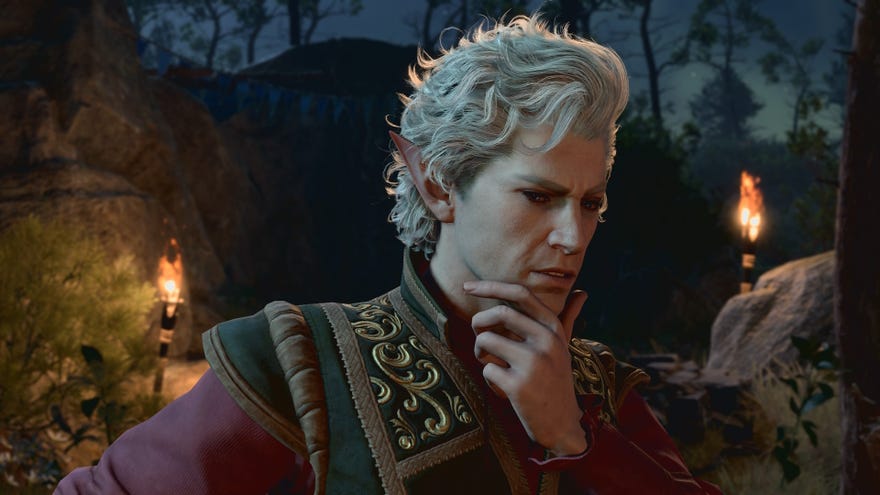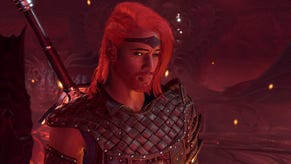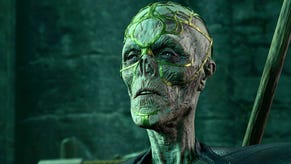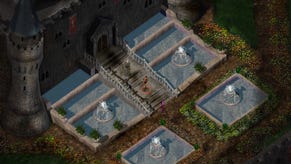Baldur's Gate 3 is about choices, but when the Dark Urge takes over you can only react
Our final impressions ahead of its full 1.0 release
Larian Studios are nothing if not enablers of wild, unspoken desires. In Divinity: Original Sin II, they provided the impossible - making each companion character a playable protagonist, and weaving their unique plotlines into the tapestry of the main story. It was one of the RPG’s great innovations - handing you a killer backstory, a tangible motivation, and a set of prompts for how you might go about roleplaying your exiled lizard prince or demon-possessed musician. For those of us who struggle with the blank page of character creation, it was a godsend (quite literally, since the adventure concerned your ascension).
Choosing a set character came with an obvious drawback, however. It robbed you of the chance to make the most of Larian’s character creation tools, fiddling with freckles and tattoos and biceps until you had an alter ego entirely your own. With Baldur's Gate 3, Larian have threaded the needle, conceiving an origin character who looks, sounds and fights however you like, yet enters the game with a frankly frightening amount of personal history and suspiciously lumpy baggage - and as they announced during the final Panel from Hell last week, some of that baggage will be soaked in blood. Optionally available as one of seven starting personalities, the Dark Urge is a mass murderer. Their species, gender, class and eyebrow thickness are up to you, but what you can’t change is their deep and insatiable need to kill for pleasure.
As I discovered during an extended play session in Larian’s home city of Ghent, Belgium, that nasty predilection colours your journey in ways big and small, although mostly in the colour red. In a game so wholly committed to player choice, it’s profoundly alarming to realise that you’re not fully in control - that occasionally, at unpredictable intervals, the Dark Urge’s subconscious will take the driver’s seat, before leaving you to clean the blood off the windshield.
For those who’ve squeezed Baldur’s Gate 3’s early access build for every possible permutation, the Dark Urge represents a twist in the tail - a final opportunity to be surprised by the game’s first act. For instance: you may know that Gale, a romanceable mage who can accompany you through the whole campaign, first appears through a portal on the roadside cliffs of the Sword Coast. Playing as the Urge, I was invited to fantasize about hacking Gale’s hand off as it emerged through the magical gateway - and as I drifted into forbidden reverie, I realised my character had actually followed through, slicing straight through the spellcaster’s arm. Afterwards, the severed hand sat wetly in the dirt, as if daring me to deny what I’d done.

Understandably, given his welcome, Gale chose to remain on the other side of that portal. But his hand remained in my inventory afterwards, except in the instances I chose to weaponize it - throwing the fingers the wizard prodigy once used to weave magic at the heads of marauding goblins. As associate writing lead Chrystal Ding tells it, there’s at least one other potential use for Gale’s dismembered hand later in the campaign.

Some of the Urge’s setpieces have a dissociative quality. At one point, while passing through a druid’s grove, Ding encouraged me to go and say hello to a squirrel. Before I knew it, the camera had snapped to a nearby tree, just in time to see the squirrel’s body splatted against the bark. It’s a scene that demonstrates Larian’s growing confidence with cinematic staging - distancing you uncomfortably from your own actions by keeping them out of frame.
Yet the squirrel was just the start of it. Back at camp, I tucked myself into bed, only to discover a brutalised corpse of my own making during the night. There followed a sequence in which I was given the option to marvel at my handiwork, wash my hands of blood, and hide the body in the bushes. Most intriguingly of all, the whole sequence played out beyond the view of my co-op partner - leaving it up to me to confess the crime, or not. It strikes me as a classic tabletop dynamic - with one player given the choice to hide their cards, and delight in the transgressive glee of keeping a secret from the table.

Baldur’s Gate 3 has long been pitched as a game that stands alone - more an attempt to capture the spirit of tabletop Dungeons & Dragons than a direct sequel to Bioware’s first ever RPGs. Yet as its August 3rd release date approaches, thematic links to the original Baldur’s Gate games are beginning to emerge. Back then, we played a Bhaalspawn - potential heir to the throne of the god of murder, whose inner darkness slowly bubbled to the surface as the series wore on. The parallels with the Dark Urge’s undercurrent of awfulness are clear, and once you’re looking, you start to see the shape of that suppressed danger everywhere.
It’s there in the newly announced companion Karlach, a tiefling barbarian whose infernal engine threatens to burn her up - the flames already licking at the horns on her head. And it beats in the heart of Gale, whose chest houses a Netherese Destruction Orb which, if not disarmed, will eventually explode like a nuke. Then there are the tadpoles that live in the head of every character who survives the Nautiloid ship crash in Baldur’s Gate 3’s opening - slowly transforming their hosts into tentacle-faced Mind Flayers. In each case, there’s a tantalising power to be harnessed - tempting you to embrace that inner darkness even as it destroys you and your friends.
“This was the magical link, you just followed it,” says Swen Vincke, Larian’s CEO and creative director. “That’s literally it. Whenever we judged the main story or companion stories, it was always against that. You’ve got this monstrosity forming inside of you. Embracing it comes with benefits, and non-benefits. So what are you going to do? What are you ready to sacrifice for it? And can you convince others of what your cause is going to be? That’s what the game is.”
The battles inside your head, then, are the precipitating events that ultimately spill out into the Sword Coast, affecting those around you and the region as a whole - right up until you finally reach the besieged city of Baldur’s Gate, and either become its last desperate hope, or its conqueror. I ain’t never heard of no hero called the Dark Urge, but hey, those are just the cards in your starting deck. How they’re played is up to you.
Disclosure: Former deputy editor Adam Smith (RPS in peace) is now the lead writer for Baldur's Gate 3.








